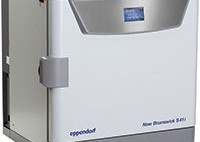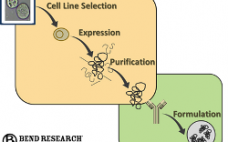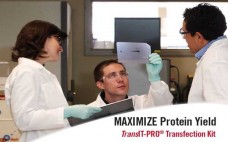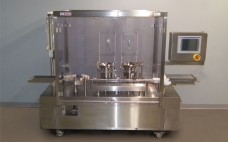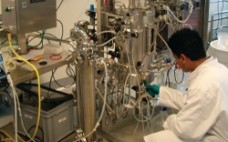This webcast features: Ma Sha This Ask the Expert webcast features Dr. Ma Sha, Director of Technical Applications for Eppendorf, Inc. In this webcast, presented to a live audience on May 6, 2014, he demonstrated the success of large clinical-scale culture of human adipose-derived mesenchymal stem cells (AdMSCs) in a BioBLU 5c single-use bioreactor at 3L scale. You can view the webcast here (Registration Required) Link to paper mentioned in presentation: A Novel Method for the Expansion of Mesenchymal Stem…
Webinars
KrosFlo® Research IIi Tangential Flow Filtration System
Spectrum Laboratories’s the KrosFlo ®Research IIi Tangential Flow Filtration System (KRIIi) is the only commercially available system with hold up volumes as low as 1 milliliter. Spectrum’s innovative, semi-automated TFF System, is ideal for small volume, R&D scale microfiltration and ultrafiltration. The KRIIi system can be used to concentrate and wash, viruses, proteins, nano-particles, and cells, at low volumes, with remarkable recovery rates. Hollow Fiber Tangential Flow Filtration is fast becoming the preferred method of large and small scale processing, due to outstanding efficiency and easy scalability compared to cassette or centrifugal devices.
Driving Optimal Cell-Level “Observability” and Data-Driven Process “Guidance”
In the spirit of implementing PAT (Process Analytical Technology), biopharmaceutical companies are striving to gain a more fundamental understanding of what is happening to the cells within their bioreactors. Implementation of online tools like Raman and Dielectric Spectroscopy are helping to provide insight, yet there is still a gap integrating this data with off-line measurements such as cell density, viability, metabolite levels and titer. Bend Research, in collaboration with major biopharmaceutical companies, is working to advance MAST, a modular, automated sampling platform that can provide samples directly from bioreactors to analytical devices, while maintaining process sterility. In this webcast, Clint Pepper, Ph.D. and Lisa Graham Ph.D., P.E. of Bend Research focus on this overall cell-level “observability” concept and illustrate how the MAST platform is incorporated.
Bioreactor Monitoring – Best Practices for Cell Counting, Sizing, and Viability
Manufacturers utilizing bioprocesses for production need accurate and reliable tools for monitoring bioreactors. The key parameter that many bioprocess engineers rely on is viable cell density. This is a compound parameter arising from knowledge of the cellular concentration and the total cellular viability. Viable cell density is the mathematical product of these two primary pieces of information. In order to minimize variability, the detection technique of each of the primary measurements (concentration and viability) must be understood separately.
In this educational webcast, Matthew N Rhyner, PhD., Global Analytical Marketing Manager at Beckman Coulter Inc, discusses two of the most powerful techniques for assessing concentration and viability: the Coulter Principle and flow-based imaging. Join Dr. Rhyner as he compares the strengths and weaknesses of these techniques and discusses competing technologies. The webcast concludes with some recommendations for best practices in monitoring cell count, size, and viability.
Mirus TransIT-PRO® Transfection Kit for Biotherapeutic Protein Production
Decrease time to produce usable protein by maximizing target protein yields through transient transfection. The TransIT-PRO® Transfection Kit uses animal origin free components designed for high and reproducible nucleic acid delivery into suspension CHO and 293 derived cells. Since it is compatible with varied media formulations, the same media can be used for both transient and stable expression. The TransIT-PRO outperforms linear PEI in protein yield, while providing a cost-effective alternative to FreeStyle™ MAX and 293Fectin™ Transfection Reagents.
Small Scale Automated Vial Filling
For small scale vial filling operations the FLT features an ideal platform. With the ability to automatically fill, stopper, and cap most common vials with minimal size parts and a user friendly control system the FLT has the features big machine features in a compact package. The mobile cart and standard utility requirements the FLT can be utilized by several different users in a lab situation. The FLT can be used with a peristaltic pump, or a rolling diaphragm dosing system, both of which are available as a single use option from the Bosch PreVAS dosing system family. Utilizing an automated system reduces filling error and product loss in comparison to manual filling operations, reduced operator fatigue and improved productivity without adding headcount.
Scale-Up of Single-Use Depth Filtration Systems
Process development engineers are responsible for developing scale-up strategies for efficient and cost-effective manufacture of biological and bioprocess-derived products at bench-scale, pilot scale and at manufacturing scale. A central unit operation in the production of these various therapeutic proteins is cell clarification using depth filtration. Recently, single-use depth filtration technologies have been developed, at scales ranging from the lab, to R&D, process development and on to manufacturing.
In this educational webcast, Laura Brown, Scientific Application Support Specialist II with 3M Purification, will provide guidelines for scaling-up of single-use depth filtration systems, and will review the commonly used single-use depth filtration products used for biopharmaceutical manufacturing.
Rapid Development of Chemically Defined Media and Feeds through Replacement of Basal Hydrolysates
Protein hydrolysates are widely used in mammalian cell culture to improve cell growth and recombinant protein production. However, use of the hydrolysates can lead to significant process variability, due to the limited control of their source and final composition during manufacturing. On the other hand, development of chemically defined media and feeds requires a tremendous amount of work, including comprehensive library screening and spent media analysis.
In this educational webcast, Dr. Hao Chen, Associate Principal Scientist, BioProcess Development at Merck, describes a rapid method for developing chemically defined media and feeds for Chinese hamster ovary (CHO) cell lines from existing proprietary media and feeds by the replacement of basal protein hydrolysates with novel supplements. In the case studies presented, Dr. Chen shows that after two rounds of optimization, the protein hydrolysate was successfully replaced. The resulting cell growth, protein productivity, and product quality were similar in the chemically defined and original media. The entire development process was completed within six weeks.
Applied Biosystems® GoPure™ Prepacked Chromatography Columns
Convenient, flexible, and efficient purification of biomolecules
GoPure™ Pre-packed Columns: A high performance, flexible purification platform
Single-use technologies have been widely utilized in upstream processes for many years. Interest in improving operational efficiency, speeding facility turn around and elimination of product carryover risk is now driving adoption of ready-to-connect filtration and purification modules in downstream processing.For chromatography, performance and flexibility that is equivalent to traditional self-pack columns is a prerequisite for use in multiproduct facilities. This webcast will describe GoPure™ Pre-packed Chromatography Columns and a custom packing process for third party resins. Case studies will be presented that demonstrate column packing process stability and scalability.
Intensified Manufacturing: Economic Models Comparing Steel, Single-Use and Concentrated Process Options
Refine Technology, LLC, in conjunction with Biopharm Services, developed two economic models to examine the cost of goods and capital requirements of cell culture production facilities configured based on different production scenarios, including variables such as:
• Amount of product required
• Vessel sizes
• Number and type of vessels (stainless steel vs. single use)
• Product titer
• Seed train
• Upstream and downstream requirements
In this educational webcast, John Bonham-Carter, Vice President of Sales and Business Development at Refine Technology, analyzes the effect of these variables in relation to operating mode, continuous culture (perfusion) versus traditional fed batch. Join John as he presents results and discussion for facilities producing 50 and 500Kg of protein per year.

